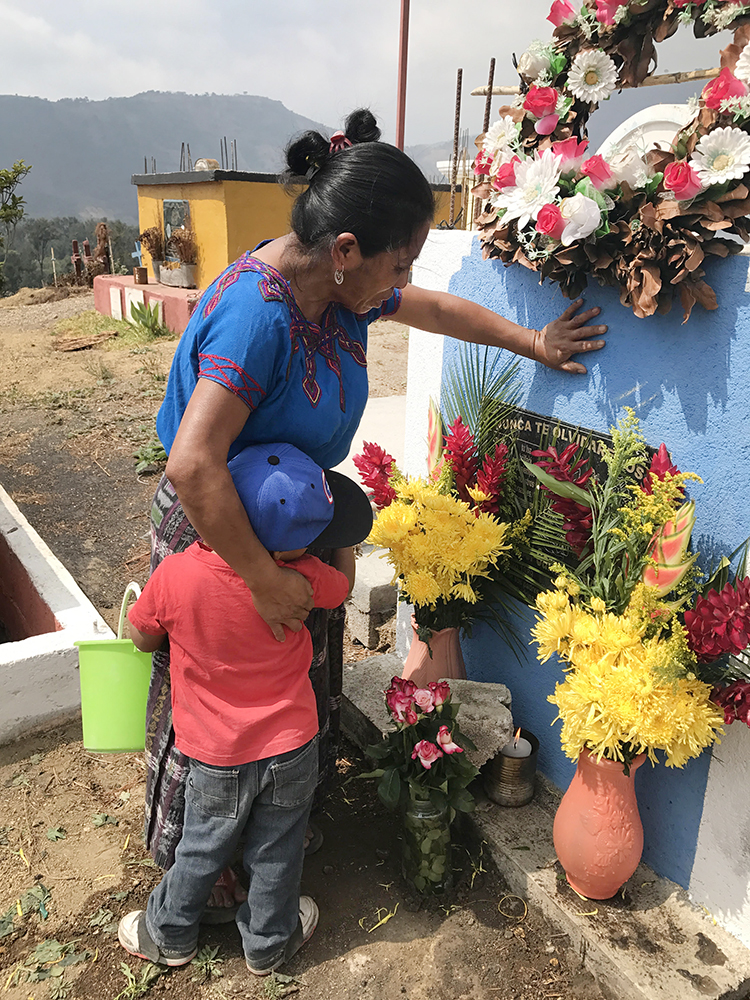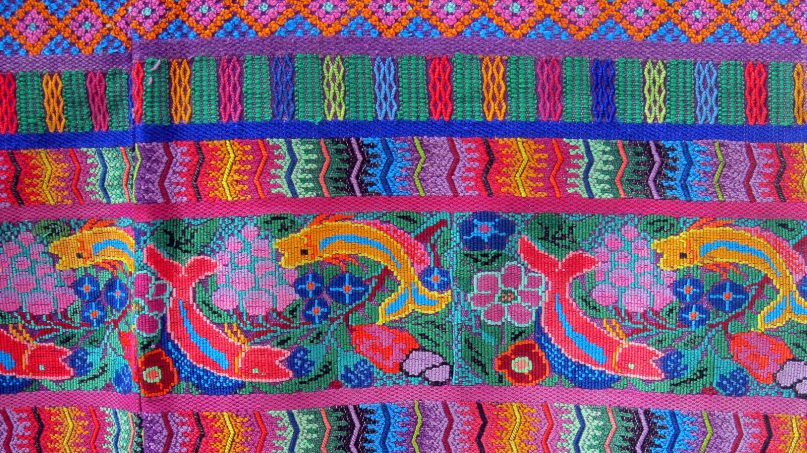(RNS) — I had known little about death at 34 when I came to the colonial city of Antigua, Guatemala, in 1993 to study Spanish.
One afternoon, I went to nearby San Antonio Aguas Calientes, a pueblo at the foot of three volcanoes, to look at the weaving and missed the bus back to my guesthouse in Antigua. Irma Hernandez Carmona, a thin Mayan woman with long black hair and high cheekbones who looked to be in her mid-20s, found me wandering on a dirt road and invited me into her one-room house.
I have returned every year, once quitting my job to stay for 12 months. Soon neighbors began calling me the gringa who came back.
In time Irma asked me to be the madrina (godmother) to her three – and later five – children. The Maya, the indigenous group that makes up about half of Guatemala’s population, is mostly Catholic and evangelical Christian.
As a Jewish woman, I could hardly teach Irma’s children the fine points of Catholicism. The family had never met a Jew. A local priest had said that the Jews killed Christ. A story circulated that when the volcano Fuego spit fire, it was the devil expelling Jews from hell. But Irma had no use for such tales of hatred.
The Maya have taught me how to honor the dead, particularly during Lent, when they carry Jesus’ coffin on their shoulders. San Antonio Aguas Calientes has long been famous for producing caskets: elaborate ones carved in cedar for the rich, unadorned pine for the poor, white boxes for the young.
During my visits, too often I follow men in black suits and women wearing fine handwoven blouses, slowly winding our way through the village in funeral marches accompanied by ragtag brass bands.

Irma Hernandez Carmona and her grandson visit the grave of Irma’s daughter, Kendy Carmona Hernandez, in San Antonio Aguas Calientes, Guatemala. Photo by Julia Lieblich
Only when I walked with scores of people in the funeral procession for my beloved 27-year-old Maya goddaughter, Kendy Carmona Hernandez, did I understand what the Guatemalans know: the need to name and remember the people some politicians would have them forget. I might have learned about healing from the mothers who lose children in my city of Chicago. Had I been raised religiously I would have known the comfort of sitting shiva. But a Maya village is where I experienced the power of communal mourning.
Guatemala is used to endless losses after a 36-year civil war that killed 200,000, most of them Maya; one of the highest murder rates in Latin America; recent deaths of human rights activists; and violence at the border. The loss of young ones hits hardest.
Last Christmas, my adoptive family watched television news reports of streams of Maya villagers in Raxruha, in the north of the country, accompanying the white coffin of 7-year-old Jakelin Caal Maquin, who died in U.S. Border Patrol custody. A month later, they saw the village of Yalambojoch, close to the border of Chiapas, hold a candlelight vigil for 8-year-old Felipe Gomez Alonzo, who also died in U.S. custody. They cried as his sister scratched his name on a tombstone with a stick.
Last May, my family followed hundreds of Maya walking in the rain outside Quetzaltenango calling for justice as they carried the casket of 20-year-old Claudia Gomez Gonzalez, shot by a U.S. Border Patrol agent in Texas.
“Guatemala is in mourning,” one sign said.
Every year when I arrived in San Antonio, I was greeted with death reports: a mother, a sister-in-law, a son. “It is life,” I heard again and again. I envied people who had the certainty of knowing they would one day see their loved ones, though it seemed to provide little solace to mothers carrying the white caskets of their young.
Religion infused everyday life. I spent hours walking at a snail’s pace in Catholic processions with my goddaughter Kendy, whose braided black hair framed a heart-shaped face and large brown eyes. Dressed in her finest huipil, an intricately woven blouse, and long skirt wrapped around her thin waist, she gazed adoringly at the larger-than-life wooden statue of Our Lady of Guadalupe that villagers carried throughout San Antonio. Even during Lenten processions commemorating the death of Christ, with bands playing funeral dirges, Kendy enjoyed every minute.
Kendy became the first in a large extended family to graduate from high school and then nursing school, and during the capping ceremony I pinned a gold hospital pin belonging to my mother, who was also a nurse, on her lapel. Kendy was the daughter I never had, the one a generous mother shared with me.
Then, in the summer of 2017, she came down with a mysterious illness. She held me tight as she moaned in the taxi to the hospital. I took her hand while relatives in veils prayed fervently over her limp body as she looked at us longingly.
When the doctors told us Kendy would live, we put roses of thanks at Guadalupe’s altar. In the early morning hours, despite doctors’ best efforts in an impoverished health system, Kendy died for reasons we will never fully know. I wrapped her in the long lace veil she had asked me to bring for her upcoming church wedding. At the village funeral in the pounding rain, I held Irma in a drenched huipil as she draped herself over Kendy’s casket.
Neighbors and relatives stayed with us night after night. Women gathered each evening to pray the rosary. Today, we visit Kendy’s grave on her birthday, on All Saints’ Day, on the Day of the Departed and whenever we feel like it, bringing armfuls of flowers, wreaths and candles. Irma and I have made elaborate altars honoring her. Mine includes a Jewish prayer book, a Buddha, a Hindu goddess and a silver staff once carried by the Maya in religious processions.
Traditional Maya rituals have largely disappeared in Kendy’s village. Maya priests are brujos, my family believes — witches who worship a hard-drinking, cigar-smoking trickster deity named Maximon. Still, though my family disapproves, I like spending time with a Maya priest in a neighboring village who tells me moving stories of the ancestors.
I have grown tired of tourists who talk about “the poor but happy Maya” as if losses don’t tear at their hearts. After her sister died, my younger goddaughter fell into a depression so severe it caused paralysis, recuperating after a wise doctor gave her medication and therapy. Only two years later does she imagine her sister at peace.
“Kendy is happy,” she told me.
“Are you sure?” I asked.
“I had a dream of her wearing a white robe and wings,” she said.
I asked her if my late atheist father, who had visited San Antonio twice, was hanging out with Kendy in heaven.
My goddaughter nodded and laughed.
I suppose it is only natural for my Mayan family to be concerned about my final resting place. Death and remembrance are in their bones, whether for a girl at the border or godmother lost.
“Do you still want to be cremated?” my compadre, the father of the family, asked.
“Yes,” I said.
“I think you should be buried next to Kendy,” he said. “At least, the urn with your ashes should be buried near her.”
I smiled, imagining the town marching at a Jewish woman’s funeral, and the children of my godchildren bringing flowers to my grave.
(Julia Lieblich is the author of “Wounded I Am More Awake: Finding Meaning After Terror” and “Sisters: Lives of Devotion and Defiance.” She is a scholar-in-residence at the Newberry Library. The views expressed in this commentary do not necessarily represent those of Religion News Service.)





